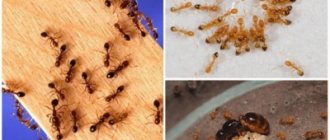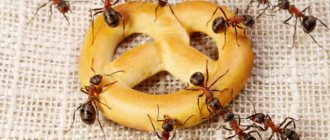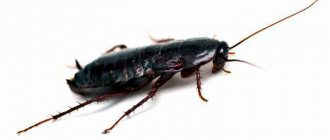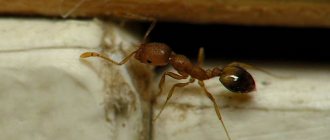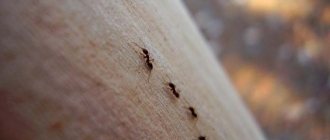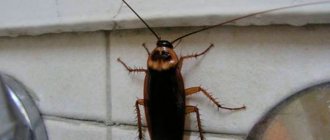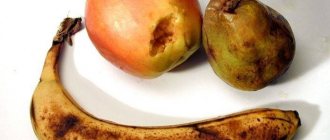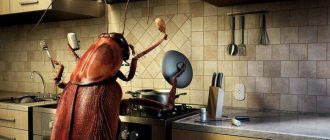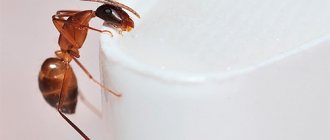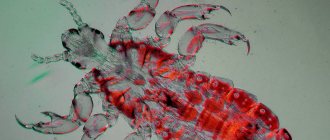Description, structure and appearance
Ants are a family belonging to the order Hymenoptera, a class of insects. There are about 14,000 species of them in the world. The size of an ant depends on its species. Representatives of the smallest varieties grow up to 2-3 mm, and the largest ones - up to 30-50 mm. In addition, the size is influenced by belonging to a particular caste. The largest in the family is the queen, the workers are smaller, and the smallest are the males.
Structure
Despite some differences, the general characteristics of all ants are the same:
- the body is covered with a chitinous shell and consists of 3 parts - head, chest and abdomen;
- the ant's head is quite large, its shape depends on the type of insect;
- on the head there are 2 complex compound eyes and 3 simple ocelli that determine the level of illumination;
- the oral apparatus is of the gnawing type, it includes the upper and lower lips, as well as powerful mandibles, which are used by insects to manipulate objects, carry food, and build;
- the antennae are geniculate, consist of several segments, are used to detect odors, capture air vibrations, and communicate with relatives;
- there are 6 paws on the chest, which are covered with small serrations and end in a hooked claw.
The internal organs of insects are located in the abdominal region. In many varieties, the esophagus ends in a crop, which stores food that the ant can regurgitate to feed the larva or another family member.
The blood of ants is a transparent hemolymph that moves throughout the body and washes the internal organs thanks to the contractions of the heart (a muscular tube running along the back). The respiratory system consists of spiracles located on the abdomen and a bundle of trachea located inside the body.
What to do and how to fight - proven advice
First of all, you need to not only find the ant nest, but also do some general cleaning.
Food supplies, especially sugar, should be located in hard-to-reach areas and securely closed. You need to vacuum, remove crumbs from the carpets, and wash the floor. Wipe all surfaces with a sponge, after soaking it in disinfectant .
The cracks through which insects can enter the apartment must be walled up. The following means can be used for this:
- glue;
- putty;
- plasticine;
- silicone sealant.
Having found a nest, you can pour boiling water over it - this will “cook” the insects alive. But the boiling water may not reach the uterus.
Reference. There are special ultrasonic insect repellers that operate on the basis of ultrasonic and electromagnetic radiation. In practice, they demonstrate low efficiency, but for some they can be useful.
Calling an exterminator
The simplest and most effective option is to turn to the services of pest control specialists.
It is especially suitable if you have not found an ant nest. Exterminators treat the premises with chemicals, so it is better for the inhabitants of an apartment or house to leave their home for a while. If ants get into an apartment building, you can fight them together with your neighbors: call an exterminator together and thereby save money. It is recommended to treat the basement, attic, and staircases. This will help prevent insects from appearing in the future.
Drawers in kitchen tables and cabinets should be cleared of food and utensils. Remove movable objects from the room for a while:
- furniture;
- toys;
- dishes;
- pots and vases with flowers.
Processing time is usually about an hour. But the components that poison the ants should remain on the surface for a day. It is worth doing wet cleaning only after a few weeks - this will help kill not only the adults, but also the larvae.
Pest control services usually guarantee that there will be no insects in the house for several months, or even years. If everything goes well, you can forget about them completely.
Chemicals
Attention. You can deal with insects yourself by using chemicals, a large selection of which are offered in hardware stores.
Some remedies provoke the death of parasites, while others act on them so that they leave the house.
Gels
The action of the gels is based on the fact that the ants themselves bring them into their nest. The poison enters the middle of the colony and infects other individuals, including the queen and larvae. The gel is applied to the ant path and left for some time to dry.
Popular anti-ant gels:
- "Dohloks";
- "Storm";
- "Face";
- Globol.
Sprays
Sprays are appropriate in cases where you know exactly where the ant nest is located.
It can be treated using an aerosol in a can or a spray prepared by diluting the concentrate. Some products have a strong odor and are toxic, so it is important to take precautions. Please note that the active components of the sprays do not affect the queen and larvae, so after a certain time the ants may appear again.
Brands producing sprays:
- "Raptor";
- "Delta";
- "Dichlorvos";
- Raid;
- "Carbofox";
- "Executioner";
- "Combat";
- "Cucaracha";
- "Tetrix";
- "Clean house".
Microcapsules
Microcapsules dissolve in water and are used for spraying. The peculiarity of such products is that the toxic components are contained in capsules that are invisible to the eye and remain on surfaces after treatment. The capsules fall on the bodies and limbs of insects and stick to them, subsequently poisoning other inhabitants of the nest.
Attention. Ant repellent microcapsules are offered by brands such as Bros and NoGuest!
Drops
Drops are a type of gel. They are applied in places where insects move onto substrates. Drops called “Rodemos” are popular.
Traps
Trapping is a very controversial method of eliminating ants.
This is explained by the fact that some of their types are effective, while others are completely useless. In addition, they differ in cost. The general scheme is this: the ant falls into a trap and dies there. The following types of traps are distinguished:
- A trap with poison and a sweet smell that is attractive to ants. The insect falls into a trap, gets dirty with powder and goes to the anthill, where it infects other individuals. The poison does not immediately kill the pest - a certain time remains in order to get the queen. Such traps are highly effective and can be made independently.
- A similar bait may take the form of plastic packaging. The efficiency is also quite good.
- Traps that immediately provoke the death of insects. They are not highly effective because they cannot solve the problem radically. They have several varieties: with Velcro, electric, and with a high content of poison. Such traps do not affect the colony and destroy only working individuals.
How effective the traps will be depends on their location, which is important to choose correctly. Here are good examples:
- joints of floor and walls;
- baseboards;
- ant trails;
- areas behind furniture in the kitchen;
- ventilation.
These are the most popular locations for ants, although they can also find more unexpected locations.
Attention. When using traps, be careful, monitor their contents and change them promptly.
You can buy traps or make them yourself. Popular purchased traps are “Combat”. The trap is presented in the form of a plastic box containing an insecticide. The main advantage is safety, which is especially important if there are children and animals in the house.
Pencils and dusts
Powder-based substances do not stick to the paws of insects as well as gels, so they are not suitable for the complete destruction of insects.
However, they can be used for prevention. Some products in this category have been used for a very long time, so insects have already become resistant to them.
Popular crayons and powders:
- "Mashenka";
- "Pyrethrum";
- "Clean house";
- "Phenaxin".
Folk remedies for insects in the apartment
In addition to chemicals created specifically to kill ants, you can use traditional methods. Some recipes are very effective.
Boric acid
Bait with boric acid is an effective way to eliminate insects. The base will be sugar, but you can use honey or minced meat instead.
- You need to combine three parts sugar, two parts boiling water and part boric acid.
- The product must cool, then it is applied to a substrate (you can take a plate or cardboard).
Boric acid in general can be applied to any food and placed like bait in various places in the apartment. Pests are attracted to the smell of food. The product is effective for two days, then the trap needs to be updated.
Important. Remember that boric acid is dangerous to humans. Children or pets should not come into contact with it under any circumstances.
Strong aromas
Like other insects, ants have a good sense of smell.
Thus, you can spray food that is located in a different apartment or even on a different floor. This can be used effectively against pests. Ants are repelled by the following odors:
- cinnamon;
- anise;
- carnation;
- Bay leaf;
- lemon;
- parsley;
- mint;
- turmeric;
- lavender;
- coffee;
- camphor;
- red and black pepper;
- garlic.
The simplest option is to use essential oils, but you can also use ground spices, the aroma of which is very pronounced. This method is effective until the aroma wears off, or until the ants find another way for themselves. Therefore, such a barrier should be updated weekly.
Vinegar
Using vinegar to fight ants is very simple: you need to dilute it with water and then treat all surfaces in the room, including floors and walls.
An ant that finds itself in such an area immediately begins to feel pain, as the vinegar corrodes its shell. If you find a nest, you can pour vinegar into it directly from the bottle. In addition to the fact that the caustic solution kills pests, it also disorients them due to the smell.
Ammonia
This substance repels ants with its smell. Alcohol, like vinegar, is diluted with water and used to treat surfaces. In order to maintain the result, it is worth carrying out the procedure at least once a week. Next, you can watch a video on how to get rid of ants using ammonia:
Range and habitats
Ants live almost all over the world, with the exception of Antarctica, where it is always cold, and some secluded oceanic islands. The successful settlement of ants in a variety of conditions is largely explained by the peculiarities of their social organization. These insects are able to quickly adapt their actions to the proposed circumstances, use available resources, and arrange the place chosen for housing to suit their needs.
Ants live in families, building comfortable nests, which are also called anthills. Insects make their homes in the ground, under stones, and in wood. Many species build above-ground dwellings on top of underground dwellings, using soil, twigs, dry leaves and blades of grass, and pine needles extracted when digging tunnels as building materials. Some species settle in trees, some occupy the nests of other ants. There are synanthropic species that live in human homes, and there are stray ants that do not have a permanent home at all.
Types of ants with photos and names
Today, scientists know about 13 thousand species of ants, with about 300 species found within our territories. The species are so similar to each other that it is quite difficult to classify them, especially if a person is not a specialist.
Therefore, it makes sense to pay attention to the most famous and frequently encountered species.
Black garden ant
This species is considered the most common species, since similar ants are found in almost all corners of our planet. Working individuals grow up to 4 and a half mm in length. Males are not significantly characterized. but large in size (up to 5.5 mm), and females have a length from 7 and a half to 11 millimeters. The body of the classic garden ant is covered with short, sparse bristles. They nest deep in the ground, under large stones, and also in unusable (rotten) wood. The main source of food for garden ants is the sweet liquid secreted by aphids. Therefore, ants not only protect aphids, but also breed them on various garden crops, which is why they can cause significant harm to the future harvest. What is interesting: the life expectancy of the queen is about 30 years, which is a record value for this category of insects.
Red myrmica
This type of ant has become widespread both on the European continent and in the Urals, Siberia and the Far East. Females of this species are reddish, up to 6 mm in length, and males are almost black and slightly smaller in size (up to 5 mm). On the body of this species you can also see, albeit sparse, short hairs. They form their nests in the ground, under boulders or under fallen tree trunks.
Small forest ants
They prefer to settle in forests with a temperate climate, distributed throughout the Euro-Asian continent. Ants are distinguished by a red-brown body color, with red cheeks and a black abdomen. They grow in length from 7 to 14 mm. Forest ants form anthills up to 2 meters high in forests. Needles and branches are used as building materials. The species is listed in the Red Books of many countries with endangered species status. Therefore, in some countries, as well as in certain regions, this insect is extremely rare.
Pharaoh ant
Egypt is considered the homeland of this species, but in our time, pharaoh ants have settled in almost all corners of the earth. Working individuals are about 2 mm long and do not have wings. Males are black in color and have wings. They grow up to 3 and a half mm in length. Females also have wings, but only until the moment of mating, after which the males rid them of their wings. They prefer to build nests in dark, moist places. They can be found even in an apartment in a wardrobe or in various household appliances.
Dinoponera gigantea
This species of ants is the largest in the world, since the length of their body is more than 3 cm. The species is distinguished by an almost black color of the body. This species lives in humid environments, in forests common in the Savannah of South America, including the Amazon River basin. This species does not have females, but they are workers who are capable of reproducing. Giant dinosaur ants live in numerous (up to 20-30 individuals) families, the nests of which are formed in the thickness of the earth, at a depth of about half a meter. Males always have wings, so they can fly.
Asian tailor ant
This ant can be found without problems in Australia, Vietnam, Thailand, Bangladesh, as well as in South India in tropical and subtropical climates. This species of ant is distinguished by its bright green color. At the same time, the abdomen is painted in red-orange tones, and the legs are beige. Working individuals are up to 8 mm in length, with males growing up to almost 1 cm in length, and females up to 1.3 cm in length. They prefer to live in trees in colonies of 500 thousand individuals, or even more. Therefore, a colony can occupy several trees at once. They build their nests from leaves, which are connected to each other using the characteristic sticky secretions of the larvae. That's why they were called "tailors".
The population of these places uses the larvae and pupae of these ants as food for poultry, as well as in traditional and folk medicine, including in the national cuisine of some Asian countries.
Eastern Liometopum
It is considered a species that is in danger of extinction, since it is listed in the Red Book, while it is an inhabitant of the Far East. Working individuals are dark brown in color and measure about 6 mm in length. Males and females are almost black and grow to 10 and 12 mm in length respectively. They build their nests in Korean pine, fir, Mongolian oak, linden, birch, etc.
Blood red ant
It is found on almost the entire Eurasian continent, with a preference for the middle zone. Working individuals have an almost black body and a brown head, growing up to 8 mm in length. The uterus is somewhat larger (up to 10 mm), red head and orange chest. Ants make their nests in tree stumps, in the ground, under various objects. With the arrival of winter, they begin to move to nests located at the base of trees. The behavior of this species is that ants raid colonies of other species and capture pupae. After that, they keep them in their nest as “slaves”.
Amazon Ant
Females of this species grow up to 1 cm in length, while males are 2 times smaller, and their “soldiers” are even smaller. The color of females and “soldiers” is yellow-red, and there are black hairs on their body. Males of this species are black in color, with brown antennae and limbs. This type of ant is common in the European part of the continent in western Asia and western Siberia. The species prefers to settle in forests, giving preference to damp areas, near clearings and forest edges. The Amazon ant also practices raids on colonies of other ants and takes pupae with them, after which it keeps them as labor.
Nomadic ants or legionnaire ants
This ant species is a subfamily of nomadic ants, which is common in tropical climates. Entire colonies of these dangerous insects are found in Central and South America, as well as within the African continent. They live in numerous colonies, consisting mainly of working individuals. Despite their relatively small size (no more than 4 mm), colonies of these insects are capable of destroying everything in their path. At the same time, they cause enormous damage to farmland.
Social structure of the colony
An ant family is a highly organized community with its own rules, which are strictly followed by absolutely all insects. All individuals included in the family are divided into 3 castes:
- ant queen;
- males;
- working individuals.
The queen ant is a fertilized female whose sole task is to lay eggs. Most often there is one queen per family, but some varieties allow several queens per family. Initially, it is the female who finds a place to live, where she lays the first batch of eggs, from which the first members of the future large ant family are born.
Queen
It is easy to recognize the queen among ants - this is the largest individual, the size of which can be twice as large, but it is difficult to find her, since the queen spends all her time in the nest, not getting out.
Males are winged ants that are needed solely to fertilize young females. They can be compared to drones in a bee colony. Soon after mating, the male dies.
Worker ants are sterile females. There are the most of them in the family, and all the worries about the anthill and its inhabitants fall on them.
There is a strict hierarchy in the ant family. Each worker performs certain duties, and experienced insects teach young ones, passing on their knowledge and experience. So, what kind of ants are there in the anthill:
- nannies - care for eggs and larvae;
- builders - they are engaged in arranging the anthill, expanding it, restoring it in case of destruction;
- foragers - get food;
- doctors - monitor the health of family members, for example, they can amputate a damaged limb;
- soldiers - these ants protect the anthill and attack other types of ants;
- storekeepers - monitor the safety of food supplies inside the anthill.
As the size of the community increases, the number of professions increases, and the specialization of each individual narrows.
Anthill structure
An anthill is a complex structure consisting of many isolated chambers and compartments connected by tunnels and passages. The dome-shaped structure made of sticks and blades of grass, which we used to call an anthill, is actually only part of the ants’ home; the main part of the nest is underground.
The construction of an anthill begins at the moment when a fertilized female finds a suitable place and, having built a small chamber underground, lays eggs. After some time, the worker ants that are born begin to gradually create a nest around this chamber. They work hard, and thanks to their efforts, the housing becomes more and more spacious and comfortable.
Depending on the type of ant, the anthill may look different, but in general the internal structure will be similar. Inside the ant house there must be:
- “solarium” - this chamber is located right under the dome, where insects warm themselves;
- wintering compartment - located deep underground;
- the room where the queen lives and lays eggs;
- nurseries - compartments in which eggs and larvae are located;
- pantries for storing food supplies (separate for plant and animal food);
- aphid chamber;
- a chamber in which waste and corpses of dead ants are stored.
The life of an anthill does not stop in winter. Insects climb into deep passages underground, feeding on reserves made in the summer.
Methods for controlling ants in an apartment
Insect control drugs must have a prolonged effect so that the foraging ant brings poison to both the queen and other ants.
Conventionally, funds can be divided into:
- folk;
- chemical.
Bait
The most common way to fight with improvised, folk methods is to make poisoned baits based on boric acid or borax. These drugs are sold in pharmacies without a prescription and are inexpensive. To make bait, mix a product with an attractive smell and borax in a ratio of 1 cup to 1 tbsp. l. You can take:
- raw minced meat;
- egg yolk;
- mashed potatoes.
From the resulting poisonous mixture you need to roll small balls and place them on ant paths, in places where insects accumulate.
Chemical insecticides can be purchased at a hardware store. They can be:
- in the form of sprays (Raptor, Fumitox, Get);
- gels (FAS, Global, Raptor, Reid). The drug is applied around the perimeter of the room;
- granular substances that are placed on paths, in cracks behind skirting boards, etc. (Dr. Klaus, Zarit Spider, Delicia);
- pencils (crayons): Mashenka, Clean House/
According to the method of exposure, toxic substances used in the fight against ants are divided into:
- contact, which corrode the chitinous cover of insects or clog the respiratory openings;
- intestinal - cause poisoning when entering the body with food.
Attention! Many medications should not be used in areas where children and pets are present.
Nutrition
Ants are insects with a very extensive diet. Insects do not need fats for growth, development and vital functions. The basis of their diet is proteins and carbohydrates. Protein food is necessary for growing larvae, and carbohydrate food for adults.
Nutrition
Ants can eat:
- invertebrates (mainly insects);
- honeydew and honeydew;
- plant juice;
- berries and fruits;
- seeds;
- mushrooms;
- nectar.
As for animal food, ants can both hunt insects and feed on carrion. When insects hunt, they use their jaws and sting. The ant's bite is quite painful, and some species inject a toxic substance into the victim's body.
House ants eat everything that people leave - from bread crumbs and grains of sugar to sausage scraps and drops of vegetable oil.
Why are ants dangerous?
It is believed that house ants do not cause significant harm to humans. But insects can still harm your health. Contact with sewage and then with food allows them to spread various infections. Many clean owners experience discomfort and irritation due to the appearance of uninvited guests in the apartment, who crawl around the apartment, get into bags of garbage, cereals and dried fruits, as well as into bread bins, sugar bowls, and cutlery. Therefore, it is necessary to quickly get rid of uninvited neighbors.
Advice!
Ants can transmit infections not only by entering your garbage bag. Insects can unexpectedly come from neighbors along with other people's microbes.
Insects are able to penetrate electrical and household appliances, thereby causing short circuits in the wiring. They can show aggression towards a person - bite a newborn baby, which will cause itching, allergic reactions, and anxiety in the baby.
Reproduction and lifespan
Since ants are fully metamorphosed insects, they go through 4 stages of development - egg, larva, pupa, adult.
Most often, ants reproduce once a year. When the mating season begins, males and young females mate. After this, the fertilized queen lays eggs, giving birth to the first members of the new ant family. Interestingly, females of most species mate once in their lives and then store sperm throughout their lives, gradually using it up.
At the end of the incubation period, sedentary larvae appear from the eggs, similar to small worms. Depending on the type of ant, as the larva grows, it molts 3 or 4 times. At the end of the last moult, the larva stops eating, empties its intestines for the first time in its life, and then pupates. Finally, a young ant emerges from the pupa, but it cannot get out of the cocoon on its own; the help of workers is required.
In ants, the sex of the future insect is determined at the stage of fertilization and egg formation. Since the seminal fluid in the queen's body is not always distributed evenly, not all eggs are fertilized. Unfertilized ones produce males, while fertilized ones produce workers and future queens.
Life expectancy directly depends on gender and belonging to a particular caste. So the male lives 2-3 weeks, worker ants 3-4 years, and the queen can live 20 or more years.
Larvae
Features of reproduction
The reproduction of ants is interesting because in some species, eggs laid by the female may be subject to aggression from the rest of the inhabitants of the colony. It's all about the special functioning of the anthill. Thus, all females can lay eggs at the same time. But at the same time they must note the fact that offspring are laid by the enzyme. If the insects did not do this, all their offspring will suffer a tragic fate. For ants, order in the colony is above all else.
Benefits and harms
It is difficult to overestimate the role of the ant in nature. Insects perform many useful functions, including:
- regulate the number of insects, including pests;
- digging holes in the soil contributes to its enrichment with oxygen;
- plant waste found in the ants’ home gradually decomposes, making the soil more fertile;
- Formic acid secreted by insects is used in pharmacology and medicine.
But ants cannot be called exclusively beneficial insects; you should also be aware of the harm they can cause:
- some species feed on cultivated plants, berries and fruits, causing serious damage to the crop;
- synanthropic species, living in houses, spoil food (meat, sweets, flour products);
- breeding of aphids and scale insects by ants poses a threat to agricultural plantings;
- Some varieties contribute to the spread of viruses and bacteria that can cause serious illness.
Sometimes ants penetrate the hives, which negatively affects the condition of the bees, their performance and the quality of honey.
What are the dangers and what harm do they cause to humans?
Large ants can bite painfully, but this does not apply to insects that can be found at home - their jaws are too small to damage human skin.
However, species that come from the street or breed in the garden can cause pain and even anaphylactic shock. House ants also cannot be called harmless. They can spread pathogenic microorganisms as they enter the apartment through toilets and dirty rooms. Insects carry food debris throughout the apartment and add it to hard-to-reach areas. There food spoils, mold and rot appear.
Attention! Ants are especially dangerous for those who suffer from allergies, as their waste products are strong allergens.
Insects can introduce aphids, known as one of the main plant pests, into garden areas. Aphids suck juices from the leaves of bushes and trees, as a result of which their growth slows down and fertility decreases. A sign of aphids on plants is dry and curled leaves.
Carpenter ants, which emerge from the forest, are dangerous for dilapidated buildings, as they tend to eat wood.
